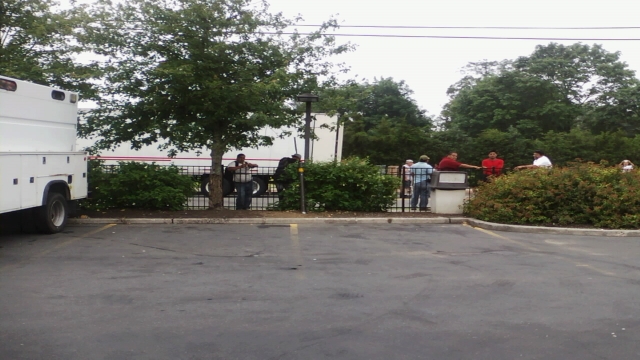As former construction worker Thomas Wedell stands outside 7-11 on North Sea Road in Southampton on an early Thursday morning, his signs attract a number of responses. Some bring him tea and shake his hand. Some honk their horns at his American flag on the side of the road. Others yell at him out of their car windows and allegedly almost come up to the curb to knock him down.
Meanwhile, dozens of men sit on the sidewalk across the parking lot, not even 250 feet away, waiting for a truck to swoop by and give them a day’s work. These men are representative of what was once nearly 300 undocumented workers in Southampton, a locale more notable for its $250 per person benefit tickets, tourism and ocean view mansions.
While these men are more noticeable while driving by in local rush hour on the side of the road in Southampton, the Senate in Washington, D.C. approved a comprehensive immigration reform bill that includes an 11-month road to amnesty for those without papers. A group of bipartisan senators (Chuck Schumer, D-N.Y.; Michael Bennet, D-Colo.; Richard Durbin, D-Ill.; Bob Menendez, D-N.J.; Jeff Flake, R-Ariz.; Lindsey Graham, R-S.C.; John McCain, R-Ariz. and Marco Rubio, R-Fla.) known as “The Gang of Eight,” formally introduced The Border Security, Economic Opportunity, and Immigration Modernization Act of 2013 this past June.
There are currently 11.1 million undocumented people in the United States, according to Jeffrey Passel, a senior demographer for The Pew Research Hispanic Center. Tallying spouses and children of undocumented workers could account for 16 to 17 million people affected by the Senate’s immigration reform package.
“Undocumented workers sometimes find labor through ‘spot markets’ which might include congregating and waiting for contractors and others to come and hire them, sometimes on a daily basis,” said Dr. David Jaeger, a faculty associate at the C.U.N.Y. Institute for Demographic Research and a professor of economics at the C.U.N.Y. Graduate Center. “For some Hamptons residents this might be problematic.”
Residents like Wedell complain that undocumented workers take up space in jails and emergency rooms. He was working on a project in Sagoponack in 2006 when he got a call saying that his team had been replaced with undocumented workers because of their cheaper rates. Wedell is now unemployed and in debt.
 |
|
Men without working papers wait for a day’s work. (Photo: Chelsea Katz) |
“In one night my crew was displaced,” Wedell said. “I’m deep in debt and why? Who’s footing the bill?”
Back in 2007, the 7-11 on North Sea Road played home to over 300 unauthorized workers standing around for a day job, according to Southampton Mayor Mark Epley. The neighboring property, which was owned by the Village of Southampton, was designated to accommodate the mass volumes of people. Epley called for federal assistance and was left empty-handed.
“I had called The White House to speak to President Bush,” Epley said. “I ended up speaking to people from Homeland Security and Immigration Enforcement. I asked what I can do and they said ‘There’s nothing you can do.'”
While there are the common complaints concerning day laborers in regard to taking space in local emergency rooms and avoiding taxation, Jaeger said undocumented workers fill a spot that needs to be loaded.
“Native workers who compete with undocumented workers will face lower wages and potentially higher unemployment,” Jaeger said. “The number of native workers with very low levels of education has been declining for a long time, so on one level, undocumented workers are probably filling a role that native workers no longer fill, but for those who do have lower levels of skill, it can be pretty tough.”
Items are also cheaper when produced by workers, like EWIs, who work at less expensive rates.
“These people are willing to do quality work at a very reasonable cost,” said Carlos Piovanetti, the managing attorney at Immigration Legal Services of Long Island in Bridgehampton and Brentwood. “It’s work in some instances that others aren’t willing to do. For instance, the wine industry in the Hamptons – picking grapes requires taking care of them by hand. This is something the average American is unwilling to do.”
Piovanetti also suggested that immigrants as a whole bring diverse food and languages to Long Island communities.
Epley was on a similar page in regard to labor.
“There’s a need for labor and there is a labor shortage and unfortunately the undocumented worker places employers in a difficult spot,” Epley said.
A number of workers who stood outside 7-11, like Mavbin, 22, of Guatemala, said that they would not take the opportunities afforded by the Gang of Eight’s bill but would not elaborate why. Mavbin has been in the United States for four years. Alfredo, 25, of Mexico, and Baldomero, 50, of Guatemala said that they would consider taking up the amnesty offer.
 |
|
Unauthorized men wait for a day’s work off the books. (Photo: Chelsea Katz) |
There are two types of unauthorized residents. Those who “enter without inspection” by Immigration and Customs Enforcement are called “EWIs.” There are also those who overstay their visas.
According to Mark Hugo Lopez and Ana Gonzalez-Barrera, writers from Pew Hispanic Research Center who interpreted company findings, found that 46 percent of Hispanic immigrants have taken the opportunity to naturalize although only 36 percent of Mexican immigrants (the largest percentage of Hispanic immigrants) have obtained papers.
At this point, Oliver Longwell, a spokesman for Congressman Tim Bishop, speculated that if the Senate’s immigration reform package were to pass through for an executive signature, it would do so with Democrat votes.
“As of now, the House is not planning to pass a comprehensive bill, but the House could pass some smaller bills that could be conferenced with the Senate’s bill to create a consensus package that would then receive a vote in the House and Senate,” Longwell said.
“Immigration is a complex phenomenon,” Jaeger said. “It involves costs and benefits both for natives and for the immigrants themselves. Overall, the economy benefits from immigrants, but there are always winners and losers.”












